As we approach 2025, the quest of the perfect streaming gadget becomes even more crucial. Considering so many options makes selecting Apple TV or Roku challenging. These two well-known streaming devices will help you to simplify your decision-making process.
Apple TV and Roku abound in unique features aimed to cater to a wide range of user tastes. Knowing their benefits and drawbacks will help you to choose whether your preference is more for the Apple ecosystem or for the adaptability of Roku.
Let’s look at what sets these products apart and decide which most likely would be the greatest streaming tool by 2025.
The Streaming Landscape in 2025
Leading the charge as we approach 2025—a more competitive streaming market than ever—Apple TV and Roku Streaming sector technical advancements have significantly impacted consumer access to and consumption of content.
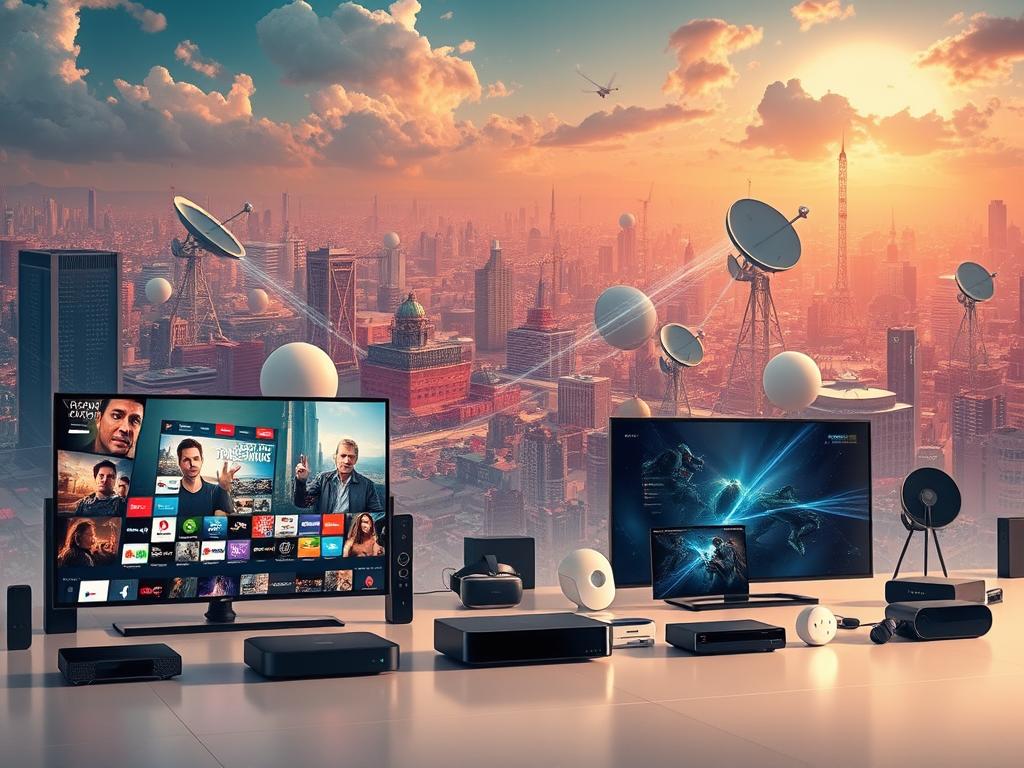
Evolution of Streaming Technology
Streaming technology has changed rapidly as advancements in content availability, buffering speeds, and video quality come about. By 2025, streaming providers will be stressing delivery of quality 4K video, enhanced audio, and customized watching experiences. Apple TV and Roku both include the newest technologies to stay ahead, therefore this technical drive has raised the expectations for streaming devices.
Market Position of Apple TV and Roku
Among the players of streaming devices, Apple TV and Roku have lately gained fairly popularity. Apple TV+ is known for perfect compatibility with other Apple devices and provides exclusive content. On the other hand, Roku is now well-known for its fairly cost range of compatible devices. Both systems are fighting hard and offer unique tools and content to attract and retain members.
Market posture of these two behemoths is affected by their diverse ecosystems, pricing strategies, and scope of content library. Knowing their market positions is vitally crucial for consumers deciding Apple TV or Roku for their 2025 streaming demands.
Apple TV vs Roku: Direct Comparison for 2025
Although choosing Apple TV or Roku can be challenging, knowing their distinctions will enable one to make a sensible decision. Both devices have particular features and fulfill various user purposes.
Key Differences at a Glance
When comparing Apple TV and Roku, a few clear differences come out. Apple TV is the ideal solution for individuals already part of the Apple ecosystem since it is well-known for having perfect compatibility with other Apple products. On the other hand, Roku offers a larger range of interoperability with other platforms and devices.
Their substance offers still another crucial difference. Apple TV+ provides unique original content, even if Roku provides a wide range of channels and apps including some not available on Apple TV.
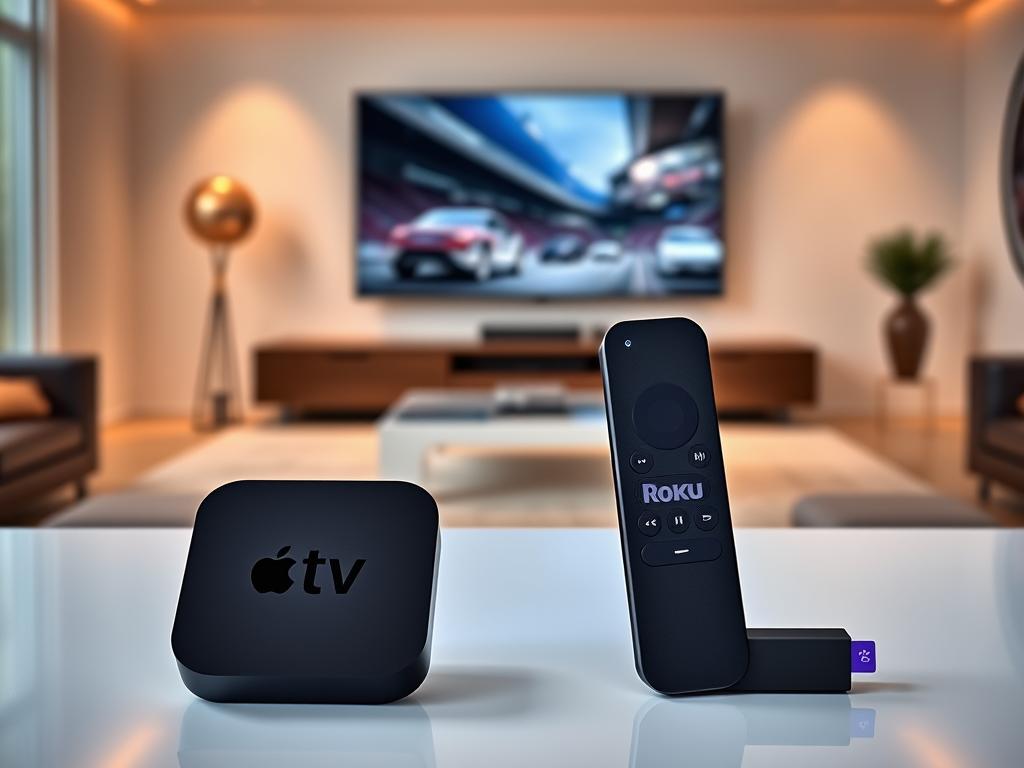
Target Audience for Each Platform
Apple TV’s target demographic usually consists of those who appreciate the simplicity of using Apple products across several devices and are rather involved inside the Apple ecosystem. On the other hand, Roku’s target market is more general and serves customers seeking for a variety of channel options not particularly connected to a specific ecosystem.
Eventually, which Apple TV or Roku one prefers comes down to personal tastes and viewing behavior. Knowing the main variations and target audience for every platform helps consumers to make a better informed decision that fits their streaming demand in 2025.
Hardware Options: Apple TV Models in 2025
In 2025 Apple TV provides options that will meet consumers’ streaming needs. Apple has kept producing its Apple TV series and offers more choices than it has ever given for its consumers.
Apple TV 4K (Latest Generation)
Available in 2025, the most recent Apple TV 4K model shows notable improvements in graphics performance and CPU strength. This tool guarantees a flawless viewing by supporting high frame rate 4K streaming. Among other things, Dolby Vision and HDR define its rich graphic experience.
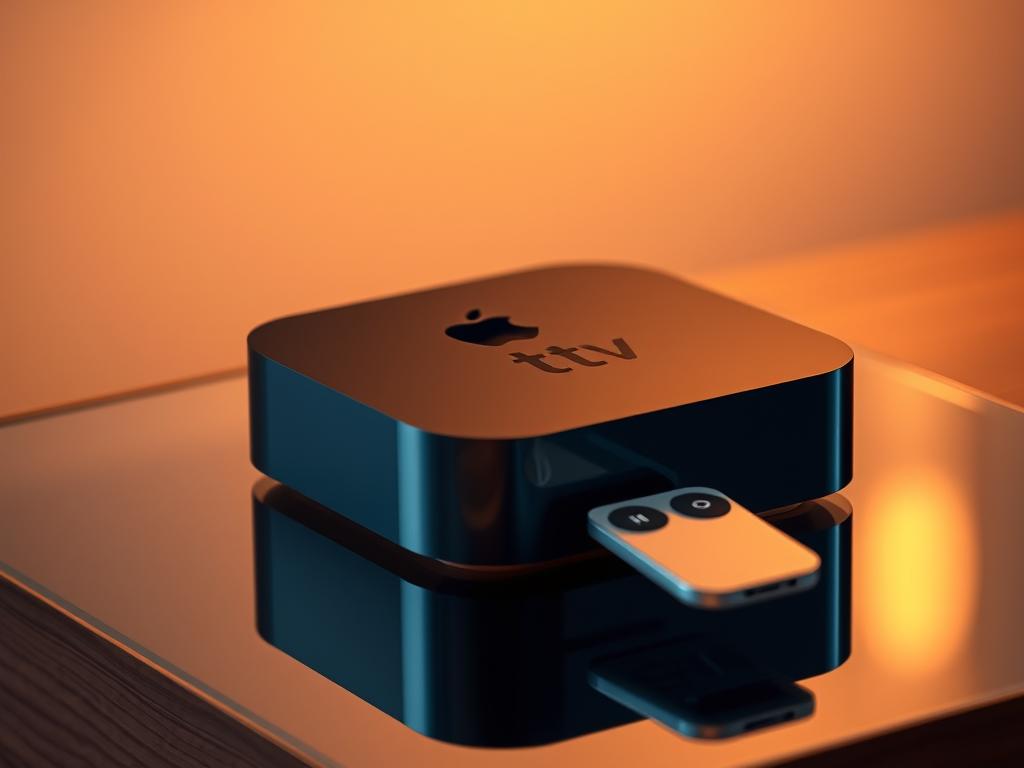
Apple TV HD
For those without need for the newest 4K technology, Apple TV HD remains a decent option. Still, it offers a high streaming quality coupled with access to a wide range of apps and services. It might not support 4K, but it can offer top-notch HD content.
Technical Specifications
Technical features of the Apple TV devices available in 2025 split out here:
- Apple TV 4K: A15 Bionic chip, 64GB or 128GB storage, supports 4K at 60fps, HDR, and Dolby Vision.
- Apple TV HD: A12 Bionic chip, 32GB or 64GB storage, supports up to 1080p.
These characteristics highlight Apple’s innovations in its streaming products, therefore providing users with choices based on their own need and price.
Hardware Options: Roku Models in 2025
Anyone looking to modernize their house entertainment system should look at Roku’s array of streaming devices as we head toward 2025. Roku has always been innovative, and its present lineup shows a commitment to providing top streaming choices at many budgets.
Roku Ultra
Modern features include 4K streaming, Dolby Vision, and HDR10+ make the Roku Ultra the flagship model. Its stronger CPU for more flawless performance and enhanced Wi-Fi capability help as well.
Roku Streaming Stick 4K
The Roku Streaming Stick 4K provides 4K streaming with HDR capabilities, small and plug-and-play. It is meant for people looking for high-quality video devoid of additional features.
Roku Express
The Roku Express is an entry-level device providing moderately priced streaming. It is ideal and enables HD streaming for people with basic streaming needs.
Roku Streambar
The Roku Streambar offers a modest fix combining a streaming device with a soundbar for those who want to enhance the audio of their TV without a separate sound system.
Technical Specifications
Here are carefully analyzed the technical details of the Roku versions that are available in 2025:
| Model | Resolution Support | HDR Support | Processor | RAM/Storage |
|---|---|---|---|---|
| Roku Ultra | 4K | Dolby Vision, HDR10+ | Quad-core | 2GB/4GB |
| Roku Streaming Stick 4K | 4K | HDR10, Dolby Vision | Quad-core | 1.5GB/2GB |
| Roku Express | HD | No | Single-core | 512MB/1GB |
| Roku Streambar | 4K | HDR10 | Quad-core | 1GB/2GB |
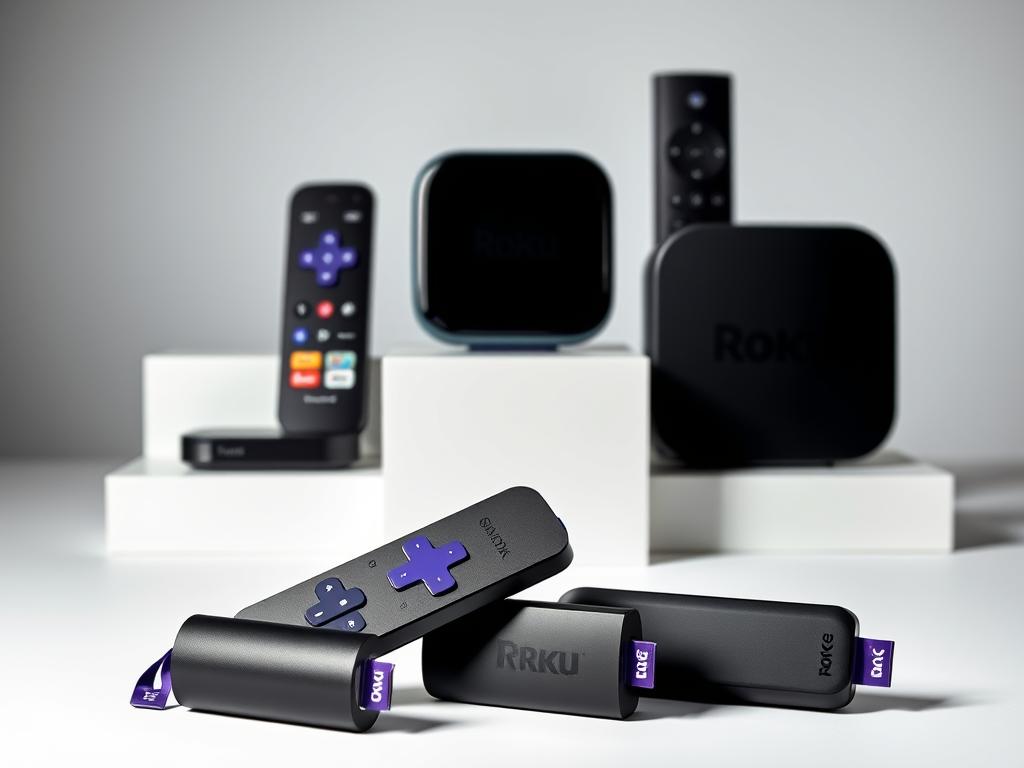
From cheaply priced devices to more advanced models with cutting-edge capabilities, Roku’s large portfolio in 2025 guarantees that there is a gadget appropriate for all user’s streaming needs.
Price Comparison: Is Apple TV Worth the Premium?
Among the factors most weighing on a streaming device is cost. Apple TV and Roku both provide a range of devices at numerous cost points to satisfy varying consumer budgets and desires.
Entry-Level Options
Basically, for roughly $30, Roku Express offers a fairly reasonably priced solution. Apple TV, on the other hand, lacks a gadget this reasonably priced; the closest is the Apple TV HD, typically running around $150.
Mid-Range Options
For Roku, the 4K Streaming Stick falls in mid-range and runs roughly $50. About $150 as stated, Apple TV HD is Apple’s mid-range offering. Roku is more reasonably priced budgetwise than other versions.
Premium Options
From Roku, the top choice is the Roku Ultra, for about $100. Apple TV’s premium option is the Apple TV 4K; starting at roughly $180 for the 64GB device and rising to $200 for the 128GB variant.
Value Proposition Analysis
Let us organize the features and costs in a table to see whether Apple TV merits the premium:
| Device | Price | Storage | Resolution |
|---|---|---|---|
| Roku Express | $30 | N/A | 1080p |
| Roku Streaming Stick 4K | $50 | N/A | 4K |
| Roku Ultra | $100 | N/A | 4K HDR |
| Apple TV HD | $150 | 32GB/64GB | 1080p |
| Apple TV 4K (64GB) | $180 | 64GB | 4K HDR |
| Apple TV 4K (128GB) | $200 | 128GB | 4K HDR |
Though they cost more generally, Apple TV devices provide a premium user experience and link with other Apple products. Conversely, Roku users offer a more reasonably priced alternative with a large spectrum of capabilities. The worth of Apple TV for the premium will depend on personal tastes in ecosystems and needs.
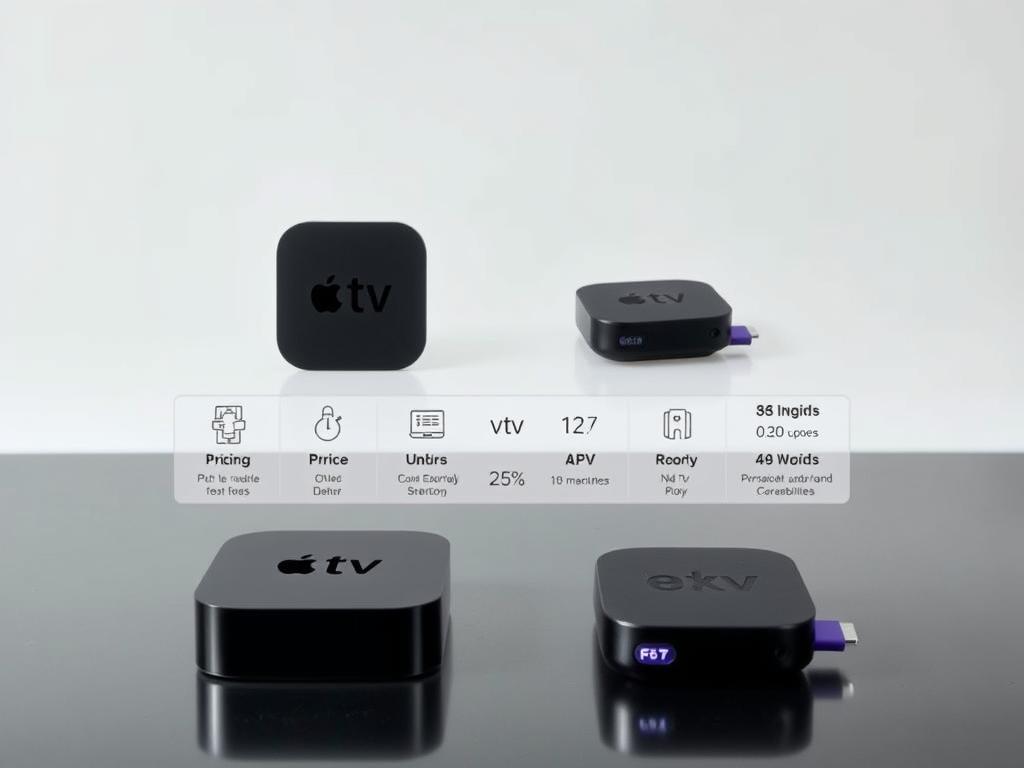
User Interface and Experience
Selecting a streaming device depends on knowing the user interface of both Apple TV and Roku. Your access to your chosen material and smartphone usage will be much influenced by the interface and fundamental user experience.
Apple tvOS Interface
From the Apple TVOS interface, slick and minimal design is somewhat well-known. Its grid-based design makes browsing among apps and contents easier. Apple TV’s strong CPUs help to make the interface also rather responsive.
Roku OS Interface
Stressing simplicity and ease of use, Roku’s running system presents a novel kind of interface. It offers a basic menu so users may easily locate and access their preferred streaming sources.
Navigation and Ease of Use
Even if Apple TV and Roku cater to different user tastes, both have simple navigation. Apple TV looks better than Roku’s UI, which is more practical. Among them, the decision mostly relies on personal tastes on look and use.
Customization Options
Another area in which both systems exhibit strengths is customizing. While Roku lets people reorganize channels and add custom themes thereby improving the user experience, Apple TV enables consumers personalize their home screen with chosen apps.
Ultimately, the user interface and experience define significantly whether one picks Apple TV or Roku. Knowing their variations in navigation, setting preferences, and interface lets customers select more intelligently in keeping with their viewing style.
Content Availability and Streaming Services
About streaming devices, Apple TV and Roku differ mostly in availability of content. Both systems offer a wide range of streaming services, although their approaches differ pretty greatly.
Apple TV+ and iTunes Integration
Apple TV+ is Apple’s exclusive streaming subscription offering exclusive content not found on other channels. Users of iTunes integration have access to a vast movie and TV show collection either renting or purchasing.
Roku Channel and Content Partnerships
On Roku’s own channel, movies, TV shows, news among other things abound. Roku has also worked with several major streaming providers to offer a broad range of material.
| Streaming Service | Apple TV | Roku |
|---|---|---|
| Netflix | Supported | Supported |
| Hulu | Supported | Supported |
| Amazon Prime Video | Supported | Supported |
| Apple TV+ | Exclusive | Not Supported |
| Roku Channel | Not Supported | Exclusive |
Third-Party App Support
Among the third-party apps Apple TV and Roku support are well-known streaming services like Netflix and Hulu.
Regional Content Differences
Content availability may vary depending on the area based on licencing agreements. The location of the user will determine if some content is accessible on one platform but not the other.
Performance and Speed Comparison
Knowing their performance differences will enable buyers choose between Apple TV and Roku to make a smart decision. Both smartphones offer advantages and disadvantages in regard to processing power, app loading times, streaming performance, and gaming capability.
Processor and RAM Differences
Driven by the A12 Bionic CPU, Apple TV gains much more processing capability than previous models. On the other hand, Roku devices have different processing capacity; the Ultra is among the more powerful types. The CPU capability directly determines the device’s performance; Apple TV often provides a superior experience.
App Loading Times
App loads speeds are absolutely vital for the user experience. Usually running under two seconds, Apple TV’s powerful A12 Bionic CPU lets apps launch fast. Though often fast, Roku players differ in their app loading times depending on the model and exact app being loaded.
Streaming Performance
Apple TV and Roku both offer great streaming capability in supporting 4K and HDR video. But for those already hooked into the Apple ecosystem specifically, Apple TV’s connectivity with other Apple products can provide a more perfect streaming experience.
Gaming Performance
Gaming performance is another instance the two smartphones differ. Apple TV supports a lot of others and can run demanding games with its robust hardware. Roku offers games even though the selection is more constrained and the performance might not be as perfect as on Apple TV.
Video and Audio Quality Analysis
About streaming, the audio and video quality can either damage or improve the viewing experience. Apple TV and Roku have made significant advancement enhancing their audio and video capability.
4K, HDR, and Dolby Vision Support
Apple TV and Roku support 4K resolution, HDR (High Dynamic Range), and Dolby Vision—offering consumers a cinematic experience directly at home. Apple TV supports HDR10, HDR10+, and Dolby Vision while Roku devices also support many HDR formats including HDR10, HDR10+, and Dolby Vision on some versions.
Audio Formats and Dolby Atmos
With relation to audio, both systems offer immersive Dolby Atmos experiences. Apple TV supports Dolby Atmos by means of its HDMI output; Roku devices with Dolby Atmos capability can stream video straight-forward.
Calibration and Enhancement Features
There are components in both devices geared to enhance audio and video quality. Apple TV allows one calibrate using its TVOS settings, but Roku offers options like “Scene Mode” to vary visual settings depending on the program being watched.
Real-World Performance Tests
Real-world tests show that Apple TV and Roku both offer first-rate audio and video. Still, the exact model, the content being shown, and the TV’s features will all influence the actual performance.
Remote Controls and Input Methods
Apple TV and Roku’s unique remote control experiences help to accommodate varying user preferences. Usually, the characteristics and usefulness of any device’s particular remote define which one to use.
Apple Siri Remote
The Apple Siri Remote boasts a touchpad for navigation and Siri integration for voice commands, all tastefully and with simple controls. Apple products are supposed to be perfect.
Roku Voice Remote Pro
On the Roku Voice Remote Pro, one finds advanced voice control, a headphone port for private listening, and a rechargeable battery. It’s designed for ease and simplicity.
Voice Control Capabilities
Both remotes have voice control elements even if they are applied differently. Siri on Apple TV has robust speech commands; Roku’s voice remote helps you quickly search and explore.
Mobile App Controls
Remote controls for Apple TV and Roku can be found among mobile apps. These apps provide supplementary features especially useful when the original remote is lost or missing.
| Feature | Apple Siri Remote | Roku Voice Remote Pro |
|---|---|---|
| Voice Control | Siri Integration | Advanced Voice Control |
| Private Listening | No | Yes (Headphone Jack) |
| Battery Type | Coin Cell Battery | Rechargeable Battery |
Smart Home Integration
Apple TV and Roku are gateways to control your smart home, not only streaming tools. The ability of streaming devices to interact with numerous smart home systems becomes even more crucial as smart home technology develops.
Apple HomeKit Ecosystem
Deeply linked with the Apple HomeKit ecosystem, Apple TV lets consumers manage their smart home gadgets via Siri or Apple TV remote. This integration allows perfect control over thermostats, security cameras, lights, and other devices.
Roku Smart Home Compatibility
Roku has also greatly improved in smart home integration with its Roku Smart Home technology. By use of the Roku app or voice commands, users of compatible voice assistants can control their Roku devices and access many smart home capabilities.
Voice Assistant Integration
Apple TV and Roku both present great integration of voice assistants. Apple TV uses Siri for voice controls; Roku offers both its own voice remote and integration with well-known voice assistants as Amazon Alexa and Google Assistant.
IoT Device Control
Mostly, integration of smart homes depends on one’s capacity to control IoT devices. While Apple TV’s HomeKit gives total control over many IoT devices, Roku’s platform supports a broad spectrum of devices by means of agreements with smart home providers.
All told, Apple TV and Roku both have really strong smart home connectivity powers. Which smart home ecosystem you choose and your personal tastes concerning voice assistants and device compatibility will determine which of them you go for.
Apple TV vs Roku vs Competitors
Only two of the various players in the field of streaming are Apple TV and Roku; Google Chromecast, Amazon Fire TV, and NVIDIA Shield all find place here. Considering all the options will help you choose a streaming device that fits your need the best.
Google Chromecast Comparison
Google Chromecast is one strange gadget that stresses casting material from mobile devices to your TV. Unlike Apple TV and Roku, which are stand-alone devices with own interfaces and remote controls, Chromecast leverages your tablet or smartphone for navigation.
Amazon Fire TV Comparison
Amazon Fire TV devices tightly connect with Amazon’s ecosystem by means of Prime Video and other Amazon services. Fire TV offers a special benefit even if Apple TV and Roku also provide various streaming services as Fire TV directly links with Amazon’s content.
NVIDIA Shield Comparison
Because of its gaming capabilities, NVIDIA Shield is a favorite pick among gamers. Although Apple TV and Roku also let some gaming alternatives, NVIDIA Shield is a more dependable gaming platform due of its robust hardware and support of GeForce NOW.
Smart TV Built-in Platforms
Many current TVs come with built-in streaming systems ranging from LG’s webOS to Samsung’s Tizen to Vizio’s Smartcast. These systems offer a convenient way to access streaming services without depending on an outside gadget.
| Device | 4K Support | Gaming Capabilities | Price Range |
|---|---|---|---|
| Apple TV | Yes | Limited | $150-$200 |
| Roku | Yes | Limited | $50-$100 |
| Google Chromecast | Yes | No | $30-$70 |
| Amazon Fire TV | Yes | Limited | $40-$150 |
| NVIDIA Shield | Yes | Yes | $150-$200 |
Every one of these devices has pros and drawbacks hence the decision depends on personal taste and requirement. Whatever your priorities—gaming, ecosystem integration, cost, or another—there is a streaming device that fits you.
Privacy and Security Features
Regarding streaming devices, security and privacy are rather critical, thus it is crucial to evaluate Apple TV and Roku’s strategies.
Apple’s Privacy Approach
Apple underlines in many important spheres its dedication to user privacy. End-to– end encryption and data sharing management tools help Apple TV users with Siri searches.
Roku’s Data Practices
Roku has, meantime, come under fire over data harvesting policies. To create suggestions and target advertising, Roku compiles watching statistics. Settings let users manage several facets of data sharing.
Ad Tracking and User Data
| Feature | Apple TV | Roku |
|---|---|---|
| Ad Tracking | Limited ad tracking; users can opt-out | Collects data for targeted ads; users can opt-out partially |
| User Data Collection | Minimal data collection; emphasizes privacy | Collects viewing data for personalization and ads |
Parental Controls
Both systems have parent controls to restrict access to specific materials. Apple TV’s “Screen Time” and Roku’s “Parental Controls” enable consumers restrict access to mature content.
Setup and Installation Process
Apple TV and Roku’s unique configurations meet different user preferences. The process for both devices is pretty straightforward, however there are some things to think about.
Apple TV Setup Experience
Just setting up an Apple TV calls for a simple, methodical procedure guided by the Apple TV remote. Users may instantly log in with their Apple ID and establish preferences.
Roku Setup Experience
Like other devices, Roku’s configuration is very basic and its user-friendly interface leads users across the procedure. One can handle Roku devices with the Roku remote or the Roku mobile app.
Wi-Fi and Network Configuration
Both Apple TV and Roku devices provide Wi-Fi connections, therefore enabling network connection. Users can also specify Ethernet configurations should they so be required.
Future-Proofing: Technology Roadmap for 2025 and Beyond
New technologies will change the streaming experience for consumers of Apple TV and Roku. Both companies are generating innovative future concepts that should improve performance, user experience, and ecosystem building.
Apple’s Development Pipeline
Apple keeps making investments in its ecosystem since Apple TV intends to incorporate more advanced artificial intelligence and machine learning powers. This tackles recommendations for customised content and improved Siri performance.
Roku’s Planned Innovations
Improving its hardware capacity and content availability comes first for Roku. The company is giving its portfolio new streaming services and improving the gadget performance.
Emerging Streaming Technologies
Soon the streaming market will be changed by new technologies including 8K resolution, cloud gaming, and advanced audio forms. These technologies are expected to be featured on Apple TV and Roku, therefore enhancing the immersive experience for users.
| Feature | Apple TV | Roku |
|---|---|---|
| Next-Gen Processor | Expected in 2025 models | Already integrated in Roku Ultra |
| 8K Support | Planned for future models | Available in select models |
| Cloud Gaming | In development | Supported through partnerships |
Who Should Choose Apple TV vs Roku?
While deciding between Apple TV and Roku, consider carefully what most values a streaming device. Each option has particular benefits to suit various user needs.
Best Use Cases for Apple TV
Apple TV is ideal for those intimately tied into the Apple ecosystem. Whether you use an iPhone, iPad, or Mac, Apple TV offers a flawless viewing experience along with basic content sharing and universal search.
- Users invested in Apple devices and services
- Those interested in exclusive Apple TV+ content
- Viewers who value high-quality video and audio
Best Use Cases for Roku
On the other hand, Roku is a flexible option that fits rather perfectly in many surroundings. For those looking for a range of streaming services, it’s perfect and does not ask for a specific brand of tablet or smartphone.
- Users who want access to a broad selection of streaming channels
- Those without a specific ecosystem loyalty
- Viewers on a budget looking for affordable options
Budget Considerations
The budget greatly affects the process of making decisions. With its entry-level versions, which usually provide more reasonably priced options, Roku is reachable to a bigger audience.
Ecosystem Integration Factors
Integration of ecosystems is yet another quite crucial factor. Should you already possess Apple products, Apple TV’s continuity features will enhance your viewing experience. For mixed-brand homes, however, Roku’s flexibility for various devices makes it an appealing choice.
Whether Apple TV or Roku is best for you will finally rely on your own needs, money, and present technology environment.
Conclusion: Making Your Streaming Decision in 2025
Apple TV or Roku will be selected dependent on many factors including money, personal interests, and ecosystem integration for your streaming needs in 2025. Both strategies have various advantages and drawbacks depending on the needs of the customers.
Apple TV excels in offering a perfect watching experience inside the Apple ecosystem because of its relationship with other Apple goods and services. On the other hand, Roku offers a flexible and reasonably priced streaming solution with many variety of channel possibilities and device compatibility.
As you choose your streaming route 2025, consider what values most to you now. If you participate in the Apple ecosystem and love outstanding audio and visuals, Apple TV could be your best choice. Roku caters to people seeking a reasonably priced fix with a lot of options for content.
The Apple TV against Roku outcome ultimately will rely on your own streaming preferences and needs. Examining the benefits and negatives of every platform will enable you to choose which, for 2025 entertainment needs, Roku or Apple TV is better.
FAQ
What are the main differences between Apple TV and Roku?
Apple TV and Roku differ in their operating systems, hardware, and content offerings. Apple TV runs on tvOS, while Roku uses its own operating system. Apple TV is known for its seamless integration with other Apple devices, while Roku offers a broader range of channels and more affordable options.
Which is better for 4K streaming, Apple TV or Roku?
Both Apple TV and Roku offer 4K streaming capabilities. Apple TV 4K supports HDR10, HDR10+, and Dolby Vision, while Roku Ultra and Roku Streaming Stick 4K also support HDR10, HDR10+, and Dolby Vision. The quality of 4K streaming depends on the specific model and your internet connection.
Is Apple TV more expensive than Roku?
Generally, Apple TV tends to be pricier than Roku devices. Apple TV 4K starts at a higher price point than many Roku models, but prices vary depending on the specific model and storage capacity.
Can I access the same streaming services on Apple TV and Roku?
Most popular streaming services, such as Netflix, Hulu, and Amazon Prime Video, are available on both Apple TV and Roku. However, some exclusive content may only be available on one platform or the other.
How do the remote controls compare between Apple TV and Roku?
Apple TV comes with the Siri Remote, which features a touchpad and voice control. Roku offers various remote controls, including the Voice Remote Pro, which also features voice control. The choice between the two remotes depends on personal preference.
Which device is easier to set up, Apple TV or Roku?
Both Apple TV and Roku are relatively easy to set up. Roku is often considered more straightforward, with a simple, step-by-step process. Apple TV setup is also easy, especially for those already using other Apple devices.
Can I control my smart home devices with Apple TV or Roku?
Apple TV supports Apple HomeKit, allowing control over compatible smart home devices. Roku also offers smart home compatibility, but the extent of its capabilities varies depending on the specific device and platform.
What about gaming on Apple TV vs Roku?
Apple TV has a more extensive gaming platform, with a wider selection of games available through the App Store. Roku also offers some games, but the selection is more limited.
How do Apple TV and Roku handle audio quality?
Both devices support various audio formats, including Dolby Atmos. Apple TV tends to have a more comprehensive audio feature set, but Roku’s audio capabilities are still robust.
Are there any significant differences in privacy and security between Apple TV and Roku?
Apple is known for its strong stance on user privacy, with features like on-device processing and encryption. Roku also prioritizes user privacy, but its data collection practices may differ from Apple’s. It’s essential to review the privacy policies of both devices.
